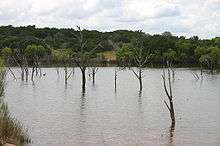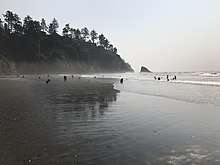Ghost forest
Ghost forests are areas of dead trees in former forests, typically in coastal regions where rising sea levels or tectonic shifts have altered the height of a land mass.[1] Forests located near the coast or estuaries may also be at risk of dying through saltwater poisoning, if invading seawater reduces the amount of freshwater that deciduous trees receive for sustenance.[2]
_(37946258775).jpg)
Looking at the stratigraphic record, it is possible to reconstruct a series of events that lead to the creation of a ghost forest. Where, in a convergent plate boundary, there has been orogenic uplift, followed by earthquakes resulting in subsidence and tsunamis, altering the coast and creating a ghost forest.
Formations
Sea level changes

When there is a change in sea level, coastal regions may become inundated with sea water. This can alter coastal areas and kill large areas of trees, leaving behind what is called a “ghost forest.” [3] This type of ghost forest may develop in a variety of environments and in many different places. In the southern US coastal marshes are expanding into dry wooded areas, killing trees and leaving behind areas of dead trees called snags. Regions of the US at or below sea level are more susceptible to tides. Coastal features affected by changing sea levels are indirectly affected by climate change. With global sea level rise, the coastlines in the southern US are being altered and leave behind salt marshes filled with dead and dying trees in some areas.[4]
Tectonic activity
Ghost forests can also result from tectonic activity. In the Pacific northwest, there is a large, active subduction zone called the Cascadia Subduction Zone. Here, there is a convergent plate boundary where the Gorda plate, the Juan de Fuca plate, and the Explorer plate are being subducted underneath the North American plate.[5] As these plates attempt to slide past one another, they often become stuck. For several hundred years the plates will be locked in place and the tension builds. As a result of this tension there is orogenic uplift. This is where the tension building between two converging plates gets translated into vertical uplift of the mountains on the coast. Orogenic uplift is usually associated with earthquakes and mountain building.[6] But then, every 500+ years, there is large earthquake in the Cascadia Subduction Zone and all that built up tension is released. The release of this tension results in what is called subsidence.[7] And with subsidence the once elevated coastline drops down several meters to below sea level. Here, sea level has not changed, but the coastline has been deformed, making it susceptible to tides. Areas of the coastline can be inundated with sea water, creating marshes and leaving behind ghost forests.
Tsunamis
In addition to subsidence, large earthquakes can also cause tsunamis. It is possible to determine that ghost forests in the Pacific northwest were created by earthquakes and subsidence by looking at the stratigraphic record. Digging down into the earth, adjacent to a ghost forest, different layers of sediment can reveal the stratigraphy in a ghost forest. Layers of material filled with organic material can indicate where the old forest floor was located prior to subsidence. On top of the layer there will often be a large sandy deposit. This layer represents the tsunami event, where the coast was flooded with sea water that is filled with sandy sediment. Superimposed on top of the tsunami deposit will be a muddy deposit, representative of an area subjected to ocean tides.[7]
Global warming
The mountain pine beetle, Dendroctonus ponderosae Hopkins, is a significant ecological force at the landscape level. The majority of the life cycle is spent as larvae feeding in the phloem tissue (inner bark) of host pine trees. This feeding activity eventually girdles and kills successfully attacked trees. Global warming has result in increased mountain pine beetle activity. These direct and indirect effects potentially have devastating consequences for whitebark and other high-elevation pines. [8]
See also
References
- ""Ghost forests": What they are and why they're becoming more common". CBS News. 1 August 2017. Retrieved 7 January 2018.
- "What is a ghost forest?". National Ocean Service. 26 October 2017. Retrieved 7 January 2018.
- "Ghost forests are eerie evidence of rising seas". Grist.org. 18 September 2016. Retrieved 2017-05-17.
- "How Rising Seas Are Killing Southern U.S. Woodlands - Yale E360". e360.yale.edu. Retrieved 2017-05-17.
- "Living with Earthquakes in the Pacific Northwest". Oregonstate.edu. doi:10.1029/2001JB001710. Retrieved 2017-05-17.
- "uplift | geology". Britannica.com. Retrieved 2017-05-17.
- "Cascadia subduction zone: Tectonic Earthquakes of the Pacific Northwest". Earthjay.com. Retrieved 2017-05-17.
- "Ghost Forests, Global Warming, and the Mountain Pine Beetle". 2001.
